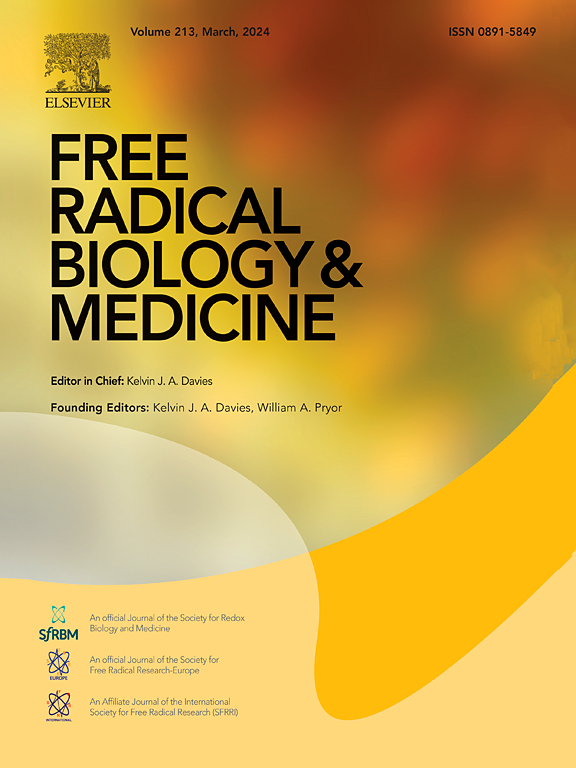在蛛网膜下腔出血大鼠模型中,抑制酸感应受体 GPR4 可通过 RhoA/YAP 信号转导减轻神经元铁凋亡。
IF 7.1
2区 生物学
Q1 BIOCHEMISTRY & MOLECULAR BIOLOGY
引用次数: 0
摘要
背景和目的:蛛网膜下腔出血(SAH)是一种破坏性脑卒中,酸中毒是其有害并发症之一。细胞外 pH 值降低可激活大脑中的 G 蛋白偶联受体 4(GPR4)。然而,质子激活的 GPR4 在多大程度上导致了 SAH 后的早期脑损伤(EBI)在很大程度上仍未得到探讨。最近的研究表明,铁凋亡(铁依赖性程序性细胞死亡)是导致 EBI 的原因之一。我们的目的是研究抑制 GPR4 对大鼠 SAH 后神经功能缺损和神经元铁突变的影响:本研究共使用了 253 只 Sprague Dawley(SD)雄性大鼠(体重 275-330g)。通过血管内穿孔诱发 SAH。SAH后1小时腹腔注射GPR4选择性拮抗剂NE-52-QQ57(NE)。为了探究其机制,还在脑室内注射了RhoA激活剂U-46619和YAP激活剂PY-60。SAH后进行了短期和长期神经行为、SAH分级、Western印迹检测、ELISA检测、免疫荧光染色和透射电子显微镜检查:结果:SAH 后,神经元中的 GPR4 表达上调。结果:SAH 后,神经元中的 GPR4 表达上调,用 NE 抑制 GPR4 可改善 SAH 后短期和长期的神经功能预后。NE 还能减少神经元铁变态反应,表现为脑组织中脂质过氧化产物 4HNE 和 MDA 水平降低,线粒体收缩减少,线粒体嵴增加,膜密度降低。应用 U-46619 或PY-60 可部分抵消 NE 对 SAH 大鼠神经元铁突变的神经保护作用:本研究表明,酸感应受体 GPR4 可通过 RhoA/YAP 通路导致 SAH 后神经元铁蛋白沉积,而 NE 可能是一种潜在的治疗策略,可减轻 GPR4 介导的 SAH 后神经元铁蛋白沉积和 EBI。本文章由计算机程序翻译,如有差异,请以英文原文为准。
Inhibition of acid-sensing receptor GPR4 attenuates neuronal ferroptosis via RhoA/YAP signaling in a rat model of subarachnoid hemorrhage
Background and Purpose
Subarachnoid hemorrhage (SAH) is a devastating stroke, in which acidosis is one of detrimental complications. The extracellular pH reduction can activate G protein-coupled receptor 4 (GPR4) in the brain. Yet, the extent to which proton-activated GPR4 contributes to the early brain injury (EBI) post-SAH remains largely unexplored. Ferroptosis, iron-dependent programmed cell death, has recently been shown to contribute to EBI. We aimed to investigate the effects of GPR4 inhibition on neurological deficits and neuronal ferroptosis after SAH in rats.
Methods
A total 253 Sprague Dawley (SD) male rats (weighing 275-330g) were utilized in this study. SAH was induced by endovascular perforation. NE-52-QQ57 (NE), a selective antagonist of GPR4 was administered intraperitoneally 1-hour post-SAH. To explore the mechanisms, RhoA activator U-46619 and YAP activator PY-60 were delivered intracerebroventricularly. Short- and long-term neurobehavior, SAH grading, western blot assay, ELISA assay, immunofluorescence staining, and transmission electron microscopy was performed post-SAH.
Results
Following SAH, there was an upregulation of GPR4 expression in neurons. GPR4 inhibition by NE improved both short-term and long-term neurological outcomes post-SAH. NE also reduced neuronal ferroptosis, as evidenced by decreased lipid peroxidation products 4HNE and MDA levels in brain tissues, and reduced mitochondrial shrinkage, increased mitochondria crista and decreased membrane density. The application of either U-46619 or PY-60 partially offset the neuroprotective effects of NE on neuronal ferroptosis in SAH rats.
Conclusions
This study demonstrated that acid-sensing receptor GPR4 contributed to neuronal ferroptosis after SAH via RhoA/YAP pathway, and NE may be a potential therapeutic strategy to attenuate GPR4 mediated neuronal ferroptosis and EBI after SAH.
求助全文
通过发布文献求助,成功后即可免费获取论文全文。
去求助
来源期刊

Free Radical Biology and Medicine
医学-内分泌学与代谢
CiteScore
14.00
自引率
4.10%
发文量
850
审稿时长
22 days
期刊介绍:
Free Radical Biology and Medicine is a leading journal in the field of redox biology, which is the study of the role of reactive oxygen species (ROS) and other oxidizing agents in biological systems. The journal serves as a premier forum for publishing innovative and groundbreaking research that explores the redox biology of health and disease, covering a wide range of topics and disciplines. Free Radical Biology and Medicine also commissions Special Issues that highlight recent advances in both basic and clinical research, with a particular emphasis on the mechanisms underlying altered metabolism and redox signaling. These Special Issues aim to provide a focused platform for the latest research in the field, fostering collaboration and knowledge exchange among researchers and clinicians.
 求助内容:
求助内容: 应助结果提醒方式:
应助结果提醒方式:


